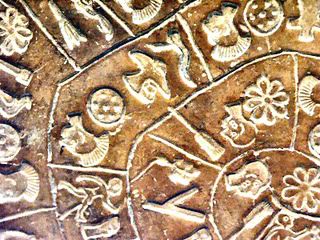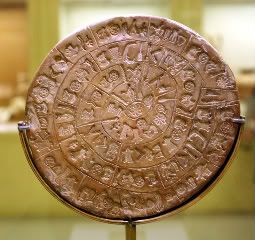The Phaistos Disc – Ancient Artifact or Modern Fake?
The undeciphered Phaistos Disc is one of the greatest puzzles of the ancient Greek world. Almost everything about this allegedly ancient artifact is controversial, from its purpose and meaning, to its original area of manufacture. The mysterious clay tablet was found on the Greek island of Crete at the ancient Minoan Palace site of Phaistos, but who made the object, what was it used for, and could it be a modern fake?
Discovery of the Artifact
The sophisticated Bronze Age civilization of the Minoans reached its height in the period around c1700 BC and began to decline about three centuries later, when many of their palaces were destroyed. The Phaistos Disc was discovered in 1903, by Italian archaeologists excavating at the ruined Minoan palace of Phaistos in southern Crete.
The archaeologists came upon the strange object in a basement room in the north-east apartments of the ancient palace, together with a clay tablet inscribed in Linear A, an undeciphered script used on Crete until around 1450 BC, and pieces of Neo-palatial pottery (c1700-1600 BC).
The ancient Minoan palace had collapsed during an earthquake, which has been linked by some researchers to the massive volcanic eruption on the nearby Aegean island of Thera (modern day Santorini) c1628 BC. The precise age of the Phaistos Disc is disputed; the archaeological context of the find suggests a date not later than 1700 BC, though the modern opinion is that it could have been created as late as 1650 BC.
Description of the Artifact and its Enigmatic Text
The enigmatic object is made of baked clay with an average diameter of 16 cm, and a thickness of 2.1 cm. Both sides of the artefact are covered with a hieroglyphic inscription arranged in a spiral. The inscription was made by impressing wood or ivory hieroglyphic seals or stamps onto the wet clay, then baking the clay at a high temperature to harden it. It has been noted that occasionally on the artifact a symbol slightly overlaps the one to its right, which demonstrates that the creator was stamping towards the left, which resulted in the text spiralling inwards to the centre. The Phaistos Disc may represent what is in effect the earliest form of printing anywhere in the world.
 Printed into the clay are a total of 242 individual impressions divided into 61 groups by vertical lines; there are 45 different signs including depictions of running men, heads with feather crowns, women, children, animals, birds, insects, tools, weapons and plants. One or two of these symbols have been identified as vaguely similar to the ancient Cretan hieroglyphs in use during the early to mid 2nd millennium BC. What is so puzzling about the artifact is why the Minoan civilization would use a primitive pictographic language at the same time as Linear A, a much more advanced script, was already in use.
Printed into the clay are a total of 242 individual impressions divided into 61 groups by vertical lines; there are 45 different signs including depictions of running men, heads with feather crowns, women, children, animals, birds, insects, tools, weapons and plants. One or two of these symbols have been identified as vaguely similar to the ancient Cretan hieroglyphs in use during the early to mid 2nd millennium BC. What is so puzzling about the artifact is why the Minoan civilization would use a primitive pictographic language at the same time as Linear A, a much more advanced script, was already in use.
Perhaps the primitive nature of the script on the artifact points to a much earlier date for the object than is presently accepted. However, this is not necessarily the case, as archaic forms of writing often survive into much later periods, usually in the form of sacred or religious texts, as was the case in ancient Egypt.
